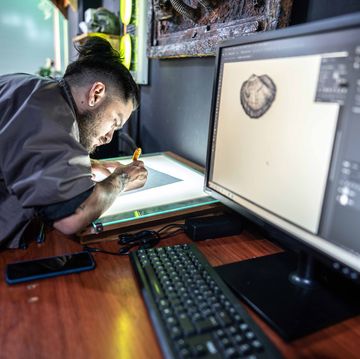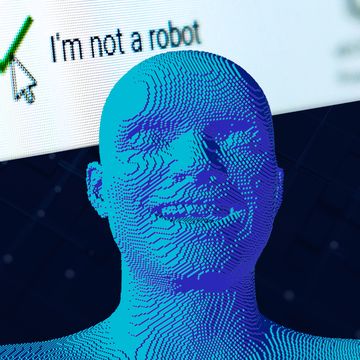It was my first time using a miter saw—or any other power tool, for that matter—and I had just finished meticulously crosscutting four 7-inch faces for a plain wooden box. Despite being a novice woodworker, I was proud of my accuracy, with each piece perfectly square at 90-degree angles.
But when it came time to rotate the saw to a 45-degree angle to cut the miters along each edge, I ran into a dire situation: The sides of the box were too tall to fit against the saw’s fence and safely make clean, accurate cuts. My design was flawed; I should have planned to create a smaller box from the get-go. Should I attempt the cuts anyway and risk sending wooden shrapnel flying in unpredictable, erratic patterns around the woodshop, or should I go back to the drawing board?
ChatGPT, the now-omnipresent artificial intelligence (AI) chatbot taking over the internet, is what got me into this mess in the first place. And when I desperately needed advice, the disembodied computer brain left me hanging.
A “Simple” Experiment
A few weeks beforehand, I had provided ChatGPT with what I (mistakenly) thought to be a straightforward prompt: “What’s a basic woodworking project I can start with?” In a matter of seconds, it cranked out a suggestion for a “simple wooden box.”
I was heartened: It was finally time to revisit a skill I had written off completely back in middle school after a botched attempt at building a gumball machine. A substitute woodshop teacher had “helped” me cut the wood by taking over completely, severely burning the wood.
Surely a box would be easier, I thought. Surely a tool like ChatGPT could be an adequate guide. But I quickly came to the realization that AI can give you just enough information to be dangerous.
The Ingenuity and Limitations of AI
ChatGPT (Generative Pre-Training Transformer) is the brainchild of San Francisco–based research lab Open AI, whose mission is “to ensure that artificial general intelligence benefits all of humanity.”
✅ Get the Facts: Artificial Intelligence
• How Does ChatGPT Actually Work?
• Everything You Need to Know About AI Reaching Singularity
• Artificial Intelligence Can’t Decipher Memes—And That Could Be Humanity’s Saving Grace
It’s trained on troves of publicly available text. Using a neural network, essentially a set of algorithms, or instructions, ChatGPT makes sense of words—much like the human brain does. The chatbot can find patterns in human language, and respond with what it believes to be the answer you’re looking for—with varied results. So when I asked it for a basic woodworking project, it based its response on a mashup of sources—and there’s no telling whether those websites, blog posts, or manuals were trustworthy in the first place, let alone the machine’s interpretation of them. You see, ChatGPT isn’t sentient; it generates sentences that make sense but lack context, authority, and expertise.
AI vs. the Amateur Woodworker
To start, I took ChatGPT’s instructions, plus its suggested materials and tools lists, at face value.
Step No. 1 seemed simple enough. Using a table saw, cut a 1x8 piece of pine board into four pieces: two sides, a bottom, and a top. But wait, shouldn’t a box have four sides, not two? How the hell do I use a table saw? And to which length should I cut each piece? Considering that a 1x8 board isn’t exactly 1 by 8 inches, I’d need to measure the wood anyway. The board’s dimensions were ever-so-slightly off, so I already needed to adjust my plans. I decided on four 7-inch square faces for the box, and that meant I needed to “rip” the wood, or cut it lengthwise along the grain.
Thankfully, Roy Berendsohn—Pop Mech’s senior test editor, and our in-house woodworking expert—was gracious enough to teach me the basics that ChatGPT skipped. He taught me how to safely use a portable table saw in our Easton, Pennsylvania, office, where I ripped the pine to 7 inches wide. That was a humbling experience, so we decided to use a cordless miter saw to proceed forward in cutting the sides of the box. Once again, Roy took me through the basics of safety and accuracy, presiding over me as I made my crosscuts.
At this point, I anticipated that Step No. 2 would require some massaging. The chatbot suggested using that same saw to cut mitered edges for the box that would fit together neatly at a 45-degree angle. This was no beginner’s task; miter joints must be precise, or the box would never fit together. In a perfect world, we’d deviate from ChatGPT’s instructions and craft butt joints instead. But to stay true to the experiment, we marched forward, arriving at my miter-joint impasse. We decided to set up a stop block to precisely cut the miters. It was a war zone: With each cut, little wooden rockets split off and flew around the shop—not exactly what I had in mind. In the end, the miters were far from perfect, so when I glued the sides together, you could see tiny gaps of light shining through.
Becoming a True Teacher?
I decided to end things there. Thanks to Roy’s lessons, and his help deciphering ChatGPT’s half-baked instructions, I had a working knowledge of the safety, accuracy, and design basics I would need for my next attempt: a 4-inch square box with butt joints.
Unlike my human instructor, ChatGPT couldn’t “read” my skill level and adjust its plans accordingly—an artifact of having mere surface-level intelligence. In this way, AI has a long way to go. Still, I was grateful for a starting point and a second chance at this daunting yet rewarding craft.
Maybe in the future, the chatbot will be able to visually interpret a student like me to gain more feedback about where the pain points lie, becoming a true teacher. In the meantime, you’ll find me down in the shop, badgering Roy with my endless questions.

















